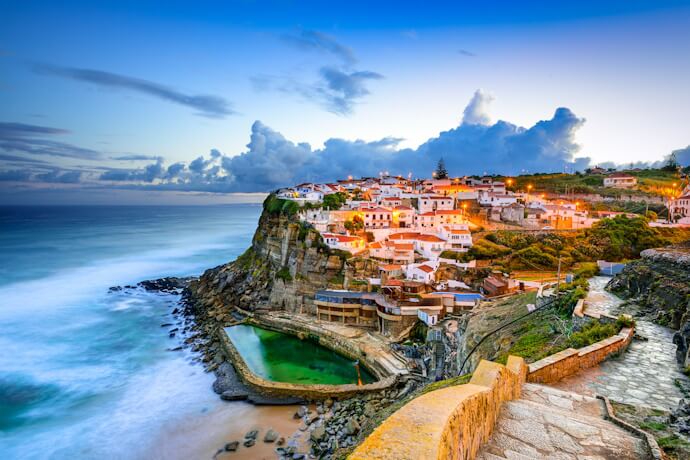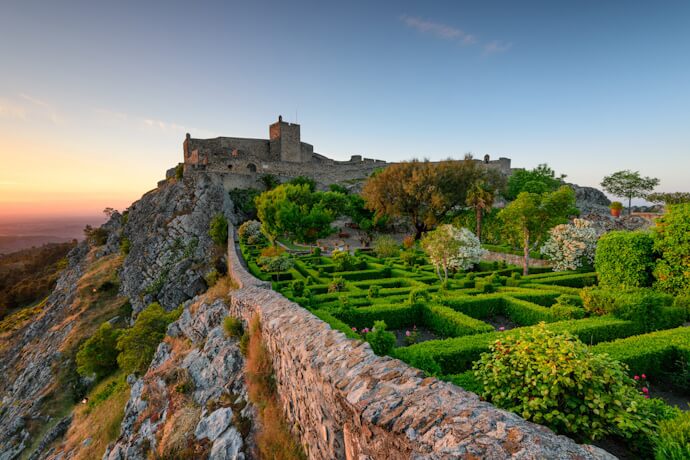Get ready for an odyssey across Portugal! This guide unfurls a canvas of ten quaint hamlets and towns, each a mosaic piece of Portugal’s grand historical and natural tableau. From the lofty, whispering ramparts of Marvão to the lapping coastal whispers of Azenhas do Mar, these destinations, best navigated by the independence of a car, promise an intimate rendezvous with Portugal's soul.
Let the allure of Portugal's lesser-known treasures inspire your next adventure, revealing the soul of a country through the charm of its small towns. Hit the road and prepare to fall in love with the prettiest towns in Portugal!
Azenhas do Mar
Azenhas do Mar, a striking seaside village in the Sintra municipality, nestled atop cliffs overlooking the Atlantic Ocean, is a scenic marvel, best reached by car, which allows travelers the freedom to explore its beauty and the surrounding region at their leisure.
The village's most iconic feature is its dramatic setting: white houses perched precipitously on the cliffs, with the ocean's vast expanse stretching into the horizon. The sight is particularly marvellous at sunset when the fading light casts a golden hue over the village and the sea.
Central to Azenhas do Mar's allure is its natural swimming pool, carved out by the ocean's force against the cliffs. This pool, alongside the whitewashed houses and narrow streets, presents a perfect harmony of nature's power and human settlement. The beach below, accessible via a series of steps, offers a tranquil retreat, with the Atlantic waves providing a soothing soundtrack.
Culinary enthusiasts will find Azenhas do Mar a delightful stop, with local restaurants serving fresh seafood, caught daily from the surrounding waters. The dining experience, with views of the ocean and cliffs, enhances the flavour of every dish.
Marvão
Marvão, perched at the summit of the Serra de São Mamede in the Alentejo region, is a hidden jewel waiting to be discovered. This medieval walled town, accessible ideally by car due to its somewhat secluded location, offers an immersive experience into Portugal's stunning natural landscapes. It is the perfect daytrip for those staying in the Alentejo region!
The journey to Marvão itself is a preamble to its enchantment, with winding roads that ascend through the lush, verdant expanses of the Serra de São Mamede Natural Park. The park, a haven for biodiversity and natural beauty, provides a picturesque backdrop.
Upon arrival, the town's impressive silhouette, dominated by its castle, emerges as if from a time capsule. Marvão's Castle, dating back to the 13th century, stands as a sentinel atop the craggy cliffs. A visit to the castle offers unparalleled views of the surrounding Alentejo plains and the serrated peaks of Spain beyond.
The historic town centre, encased within robust defensive walls, is a labyrinth of narrow, cobbled streets, flanked by whitewashed houses with traditional terracotta roofs. This architectural ensemble speaks volumes of Marvão's medieval heritage. Be sure to visit the Church of Santa Maria, housing a small museum with local artifacts.
Sortelha
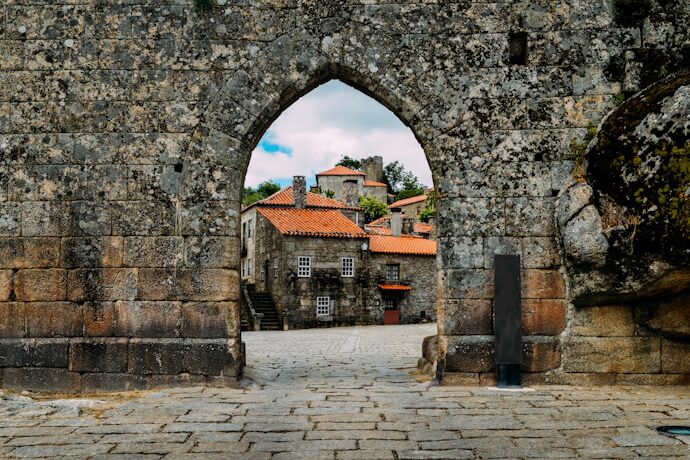
Nestled in Portugal's Centro region, Sortelha is one of the country's most preserved medieval villages, offering an unparalleled journey back in time. Unlike bustling cities with their fast-paced atmosphere and modern conveniences, Sortelha offers a peaceful retreat into history. Accessible by car, this hidden gem invites you to meander through its ancient streets, where history's echo is palpable in every stone and shadow. The village, encircled by formidable stone walls, stands as a sentinel overlooking the rugged landscapes of the Serra da Estrela foothills. It truly transports you to a bygone era where knights roamed the land and troubadours sang beneath the stars!
At the heart of Sortelha lies its imposing castle, a relic of the 13th century, offering panoramic vistas that stretch across the horizon, commanding views of the village's timeless beauty and the natural splendour of its surroundings.
Wandering through Sortelha's labyrinthine alleys reveals its many architectural marvels, from centuries-old houses to the iconic Gothic-style pillory in the main square. Each corner of the village tells a story, with the Manueline-style church adding a spiritual dimension to the village's rich historical narrative.
Lindoso
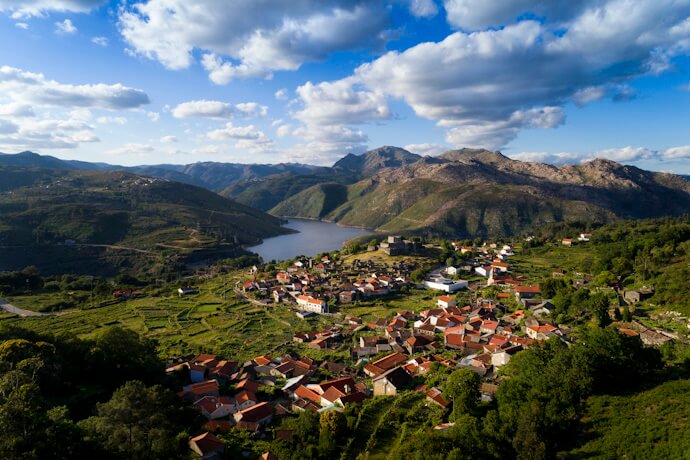
Lindoso, a quaint village nestled within the lush landscapes of the Peneda-Gerês National Park, is an ideal stop for those exploring the country's northern territories. Lindoso may be small in size, but it packs a punch when it comes to capturing hearts and stirring souls!
The village, best accessed by car, is renowned for its imposing 13th-century castle, which played a pivotal role in Portugal's defense history and still provides breath-taking views over the Lima River valley and the surrounding mountains.
Adjacent to the castle, an equally attractive sight unfolds—a vast ensemble of over 50 traditional stone granaries (espigueiros) from the 1700s. These iconic structures create a picturesque scene that encapsulates the essence of Portuguese rural life. The granaries are used for drying corn and other crops, illustrating the agricultural practices that have sustained this community through the centuries.
The surrounding Peneda-Gerês National Park invites exploration beyond the village boundaries. The park is a sanctuary of biodiversity with a network of trails that lead through ancient oak forests, cascading waterfalls, and crystal-clear rivers.
Monsaraz
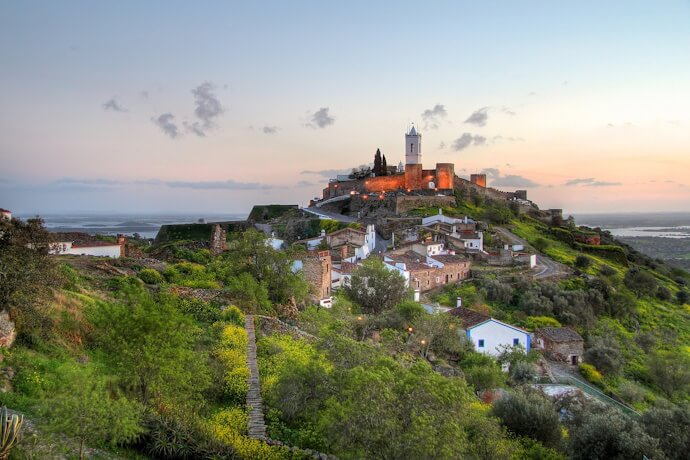
Th Perched above the tranquil waters of the Alqueva Dam, Monsaraz retains the aura of medieval times, with its pristinely conserved medieval castle, cobbled streets, and whitewashed houses adorned with terracotta roofs.
The main square, Largo do Castelo, is surrounded by notable buildings such as the Church of Santa Maria da Lagoa, the fresh and inviting space of the Monsaraz Museum, and the pillory that stands as a reminder of the village's judicial past. The narrow streets leading off the square are lined with artisan shops, local restaurants, and galleries, tempting you to delve into the local crafts and cuisine, which is rich in flavours and tied to the Alentejo's agricultural traditions.
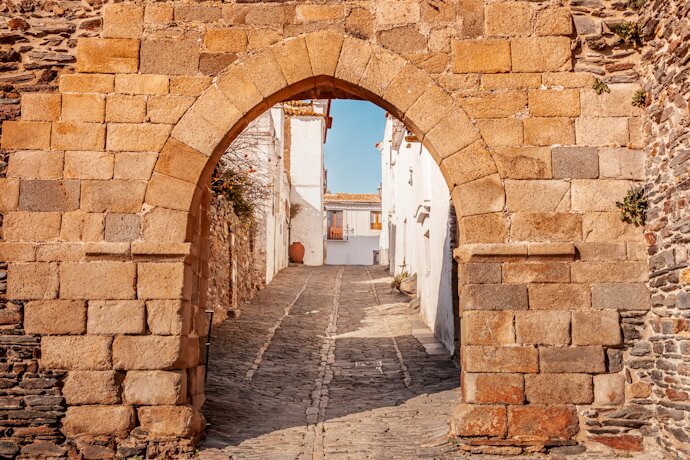
Beyond the historical allure, Monsaraz's proximity to the Alqueva Dam presents a multitude of recreational opportunities. The vast reservoir, the largest artificial lake in Western Europe, offers activities such as boating, fishing, and swimming, making it a perfect complement to the cultural exploration of Monsaraz. The region around Monsaraz is also celebrated for its wine production, with numerous vineyards and wineries that welcome visitors for tastings and tours.
Visiting Monsaraz by car allows you to experience the timeless beauty of the village itself but also to venture into the surrounding countryside, where megalithic sites dot the landscape, offering a glimpse into the prehistoric past of this region.
Amarante
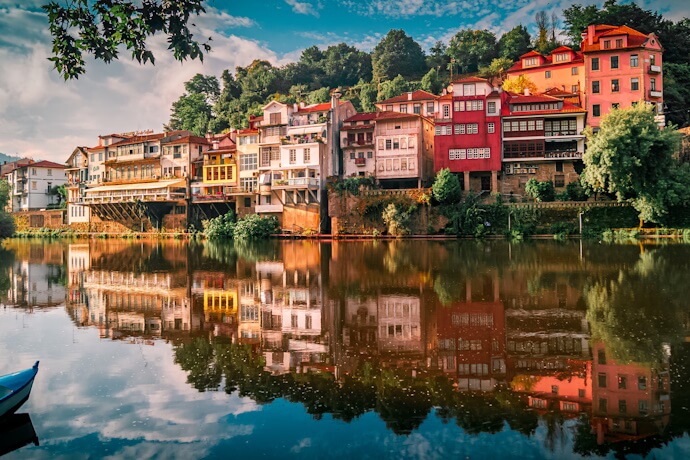
Nestled along the banks of the Tâmega River in the northern region of Portugal, Amarante is a picturesque town that combines the allure of historical heritage with the tranquility of natural landscapes. The journey to Amarante by car is convenient and enriching, allowing you to traverse the verdant valleys of the Vinho Verde wine region.
Upon arrival, the iconic São Gonçalo Bridge and church greet visitors. This medieval structure offers stunning views of the town and river, serving as a gateway to the historic center. The São Gonçalo Church, dedicated to a local saint, is a masterpiece of religious architecture, with its ornate gilded woodwork and serene cloisters.
Amarante's charm is further amplified by its narrow, winding streets lined with traditional houses, quaint shops, and inviting cafes. The town is also a haven for art and music enthusiasts. The Amadeo de Souza-Cardoso Museum, named after the renowned Portuguese painter born in Amarante, showcases a collection of modern and contemporary art that contrasts with the town's ancient backdrop.
The town is famous for its sweets, especially the São Gonçalo cakes, which are as much a part of its identity as its historical landmarks. The local restaurants serve dishes that highlight the region's culinary richness, with a focus on fresh, local ingredients.
Monsanto
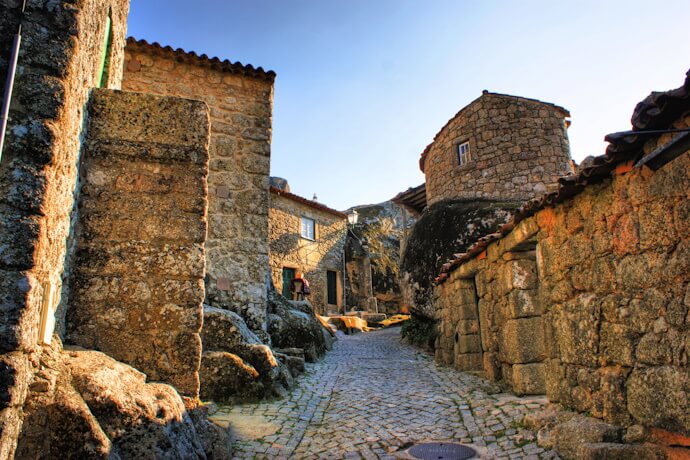
Often referred to as the "most Portuguese village of Portugal", Monsanto, situated in the Castelo Branco district, is an ancient village perched atop a steep hill, crowned by an imposing granite outcrop. The journey to Monsanto by car is a voyage through Portugal's heartland, unveiling the stark beauty of the region's landscapes.
The village's distinctive feature is its integration with the immense boulders scattered across the landscape. Houses, streets, and even furniture are ingeniously carved into and around these natural formations, creating a surreal, timeless ambiance.
At the summit of Monsanto, the ruins of the Castle of Monsanto offer panoramic views of the surrounding countryside. The ascent to the castle is a journey through history, with each step revealing layers of Portugal's past, from the Roman occupation to the medieval era.
Among Monsanto's notable landmarks is the Lucano Tower, with its iconic silver rooster perched atop, symbolizing the legend of a silver treasure hidden within the village. Another highlight is the Chapel of São Miguel, a Romanesque gem nestled among the rocks.
The local cuisine adds another layer to Monsanto's allure, with dishes that reflect the rustic, hearty flavours of the region.
Castro Marim
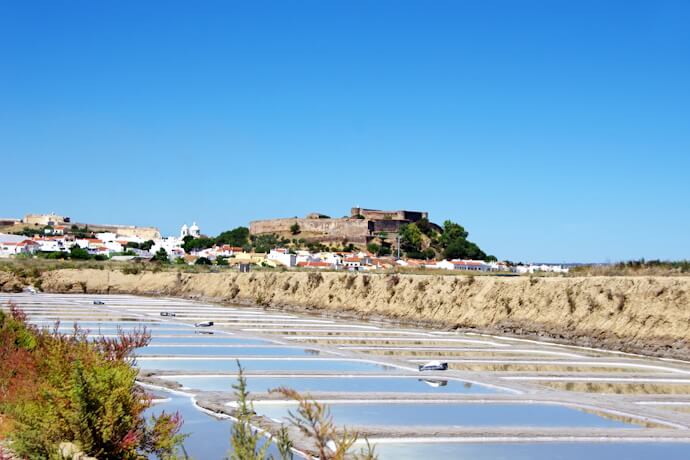
Castro Marim, nestled in the southeastern corner of Portugal's Algarve region, is a picturesque town and an invitation to explore Portugal beyond its well-trodden tourist paths, providing a serene getaway.
The town is dominated by two main historical structures: the Castle of Castro Marim and the Fort of São Sebastião. The Castle, dating back to the 13th century, offers fastastic views of the surrounding salt pans, the river Guadiana, and the hills of the Algarve and Andalusia.
One of Castro Marim's most distinctive features is its natural salt pans, which are among the few remaining operational salt pans in Portugal. These are crucial for the local economy, producing some of the finest sea salt and flor de sal, and they also create a unique ecosystem that supports a diverse range of wildlife, particularly bird species.
The town itself is a quaint and peaceful place, with traditional whitewashed houses, historic churches, and inviting squares. Beyond the historical and natural attractions, Castro Marim is also a gateway to some of the Algarve's most serene beaches, such as Praia Verde and Praia de Altura. These beaches offer a more secluded and peaceful alternative to the Algarve's busier coastal spots, with pristine sands and crystal-clear waters.
Ponte de Lima
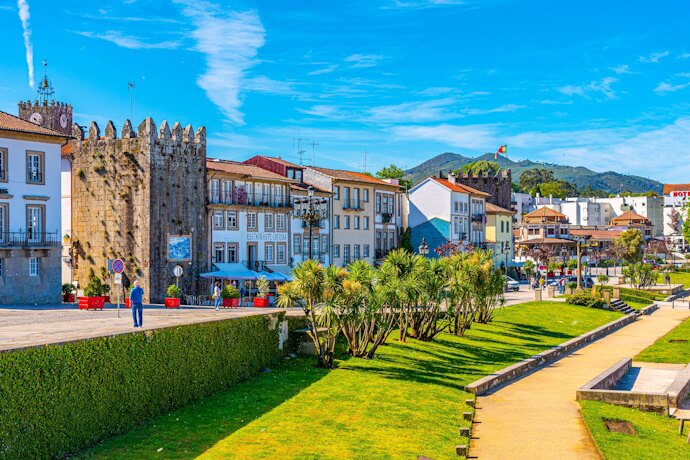
Situated in the heart of Portugal's verdant Minho region, Ponte de Lima is considered the oldest village in Portugal and is named after the Roman bridge (Ponte) that spans the Lima River, forming the centerpiece of the town's picturesque landscape. A journey to Ponte de Lima by car offers the flexibility to explore the town's heritage at one’s own pace.
Strolling across the historical bridge offers views of the riverbanks, beautifully adorned with gardens and traditional Portuguese tiles (azulejos), making it a focal point for visitors. Ponte de Lima's historical centre is dotted with plenty of architectural gems. Notable sites include the Church of Santo António da Torre Velha, with its impressive Baroque façade, and the Museu dos Terceiros, housing religious art and artifacts.
The surrounding region of Ponte de Lima is a haven for outdoor enthusiasts and nature lovers. The Lima Valley offers a range of activities from hiking and horse riding to canoeing on the Lima River. The area is also part of the Vinho Verde wine region, where you can tour vineyards and sample the light, refreshing wines that are emblematic of Portugal's northwest.
Visiting Ponte de Lima by car allows for easy access to nearby attractions, including the Peneda-Gerês National Park, Portugal’s only national park, and the historic cities of Braga and Viana do Castelo.
Óbidos
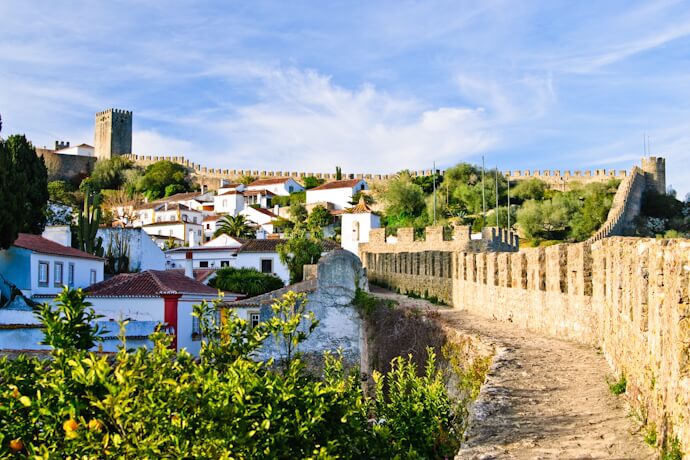
Óbidos, a charming medieval town nestled on a hilltop in the Oeste region of Portugal, is encircled by well-preserved ramparts that offer a glimpse into its historic past.
Upon entering the town through the Porta da Vila, you are greeted by a traditional blue and white tiled entranceway, leading into the narrow, winding streets lined with whitewashed houses adorned with vibrant bougainvillea. The centrepiece of Óbidos is its majestic castle, which has origins dating back to the 8th century. Now serving as a luxurious pousada (hotel), the castle allows you to experience the magnificence of Portugal's medieval period. The castle's walls provide a panoramic vantage point for stunning views of the surrounding countryside and the town's picturesque rooftops.
One of Óbidos' most enchanting features is its array of local shops and markets, where you can explore a selection of handcrafted goods, traditional pottery, and the town's famed cherry liqueur, Ginjinha. Enjoying a shot of Ginjinha in a chocolate cup is a must-do experience!
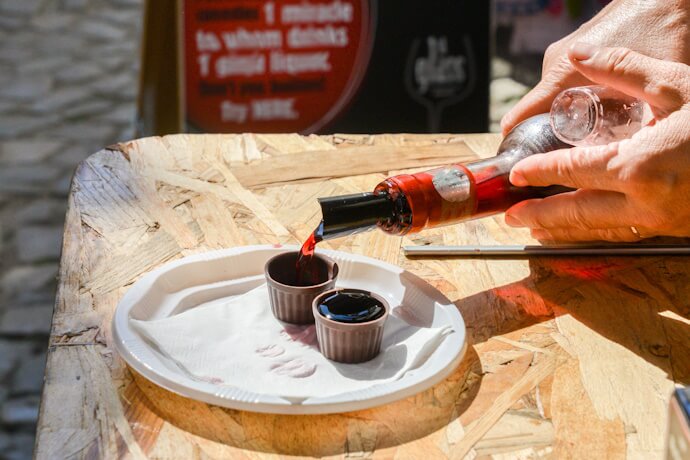
Óbidos is also known for its vibrant cultural calendar, hosting a variety of festivals throughout the year that transform the town into a lively celebration of Portuguese heritage. The Medieval Fair, taking place in the summer, recreates the medieval era with jousting knights, wandering minstrels, and open-air markets. Meanwhile, the Christmas Village turns Óbidos into a winter wonderland, and the Chocolate Festival is a haven for those with a sweet tooth.
The surrounding region offers opportunities for further exploration, including the tranquil lagoon of Óbidos (Lagoa de Óbidos), perfect for bird-watching, and the beautiful beaches along the Silver Coast, making Óbidos a well-rounded destination with something for everyone.
From cobblestones to sunsets
Next time you find yourself planning a trip to this beautiful country, make sure to add these 10 prettiest towns to your itinerary for an unforgettable experience. Sometimes, the most memorable and enriching destinations are those hidden away from the usual tourist trails, inviting the adventurous at heart to explore the road less taken!


